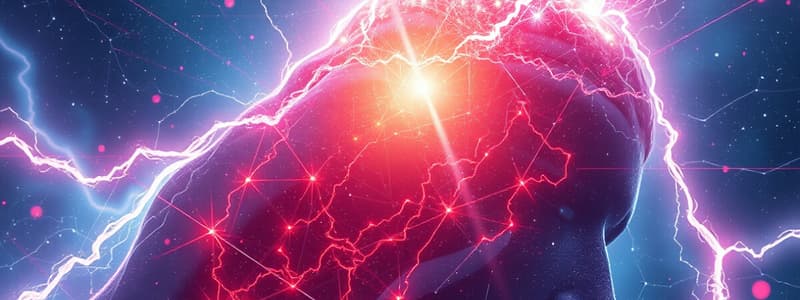Podcast
Questions and Answers
What is the main characteristic of a dielectric material?
What is the main characteristic of a dielectric material?
- It has low resistivity.
- It contains permanent dipoles.
- It can conduct electricity.
- It supports an electric field. (correct)
Which type of dielectric has permanent dipoles?
Which type of dielectric has permanent dipoles?
- Super Dielectric
- Polar Dielectric (correct)
- Conductive Dielectric
- Non-Polar Dielectric
Which of the following factors increases the capacitance of a capacitor?
Which of the following factors increases the capacitance of a capacitor?
- Increasing the distance between plates.
- Increasing the area of the plates. (correct)
- Using a dielectric with lower dielectric constant.
- Decreasing the voltage across the capacitor.
What is the unit of capacitance?
What is the unit of capacitance?
Which formula represents the relationship between charge (Q), capacitance (C), and voltage (V)?
Which formula represents the relationship between charge (Q), capacitance (C), and voltage (V)?
How does inserting a dielectric affect a capacitor's capacitance?
How does inserting a dielectric affect a capacitor's capacitance?
What happens to the energy stored in a capacitor when the voltage is doubled?
What happens to the energy stored in a capacitor when the voltage is doubled?
In a series configuration, what is the formula to find the total capacitance?
In a series configuration, what is the formula to find the total capacitance?
Flashcards are hidden until you start studying
Study Notes
Electrostatic: Dielectrics
-
Definition:
- Dielectrics are insulating materials that do not conduct electricity but can support an electric field.
-
Properties:
- High resistivity: Prevents electrical conduction.
- Polarizability: Molecules can align with an electric field, creating dipole moments.
-
Types of Dielectrics:
- Polar Dielectrics: Have permanent dipoles (e.g., water).
- Non-Polar Dielectrics: No permanent dipoles (e.g., oils, gases).
-
Dielectric Constant (ε):
- Ratio of electric field in vacuum to that in the dielectric material.
- Higher ε indicates better insulating properties.
- Frequency-dependent: Varies with the frequency of the applied electric field.
-
Applications:
- Capacitors: Used to store energy.
- Insulation: In cables and electronic components.
- Energy storage devices: Influence energy density.
Electrostatic: Capacitance
-
Definition:
- Capacitance is the ability of a system to store electric charge per unit voltage.
-
Formula:
- ( C = \frac{Q}{V} )
- Where ( C ) is capacitance, ( Q ) is charge, and ( V ) is voltage.
-
Unit of Capacitance:
- Farad (F), with 1 F = 1 C/V.
-
Factors Affecting Capacitance:
- Area of Plates (A): Larger area increases capacitance.
- Distance between Plates (d): Closer plates increase capacitance.
- Dielectric Material: Inserting a dielectric increases capacitance (C = ε_r * ε_0 * A/d).
-
Types of Capacitors:
- Ceramic Capacitors: Small, stable capacitance.
- Electrolytic Capacitors: High capacitance, polarized.
- Film Capacitors: Good stability and low losses.
-
Energy Stored:
- The energy (U) stored in a capacitor is given by ( U = \frac{1}{2} CV^2 ).
-
Applications:
- Energy storage in electronic circuits.
- Filtering signals in AC circuits.
- Timing applications in circuits.
-
Series and Parallel Configurations:
- Series: ( \frac{1}{C_{total}} = \frac{1}{C_1} + \frac{1}{C_2} + ... )
- Parallel: ( C_{total} = C_1 + C_2 + ... )
Dielectrics
- Dielectrics are materials that act as insulators, capable of supporting an electric field without conducting electricity.
- High resistivity characteristic prevents electrical conduction, making them ideal for insulating purposes.
- Polarizability allows molecules within dielectrics to align with an electric field, generating dipole moments.
- Types of Dielectrics:
- Polar dielectrics possess permanent dipoles, such as water, giving them unique properties in electric fields.
- Non-polar dielectrics lack permanent dipoles, with examples including oils and gases.
- The Dielectric Constant (ε) measures a material's effectiveness in supporting an electric field, represented as the ratio of the electric field in a vacuum to that in the dielectric.
- A higher dielectric constant indicates superior insulating properties, which can vary with the frequency of the applied electric field.
- Applications of dielectrics include energy storage in capacitors, insulation for wires and electronic components, and enhancing energy density in energy storage devices.
Capacitance
- Capacitance defines a system’s capability to store electric charge relative to the voltage applied across it.
- The formula for capacitance is expressed as ( C = \frac{Q}{V} ), where ( C ) is capacitance, ( Q ) is charge, and ( V ) is voltage.
- Capacitance is measured in Farads (F), with 1 F equal to 1 C/V.
- Key factors influencing capacitance include:
- The area of plates (A): Increasing plate area enhances capacitance.
- The distance between plates (d): Reducing plate distance increases capacitance.
- Dielectric material presence: Inserting a dielectric modifies capacitance according to ( C = ε_r * ε_0 * A/d ).
- Types of Capacitors:
- Ceramic capacitors feature small, stable capacitance and are commonly used in electronic devices.
- Electrolytic capacitors provide high capacitance and are polarized, selecting for specific circuit applications.
- Film capacitors are noted for their good stability and minimal energy losses.
- Energy stored in a capacitor is calculated by ( U = \frac{1}{2} CV^2 ), where ( U ) represents stored energy.
- Capacitors play essential roles in electronic circuits for energy storage, signal filtering in AC circuits, and timing mechanisms.
- Capacitors can be configured in series or parallel:
- In series, total capacitance follows ( \frac{1}{C_{total}} = \frac{1}{C_1} + \frac{1}{C_2} +...).
- In parallel, total capacitance combines as ( C_{total} = C_1 + C_2 +...).
Studying That Suits You
Use AI to generate personalized quizzes and flashcards to suit your learning preferences.




